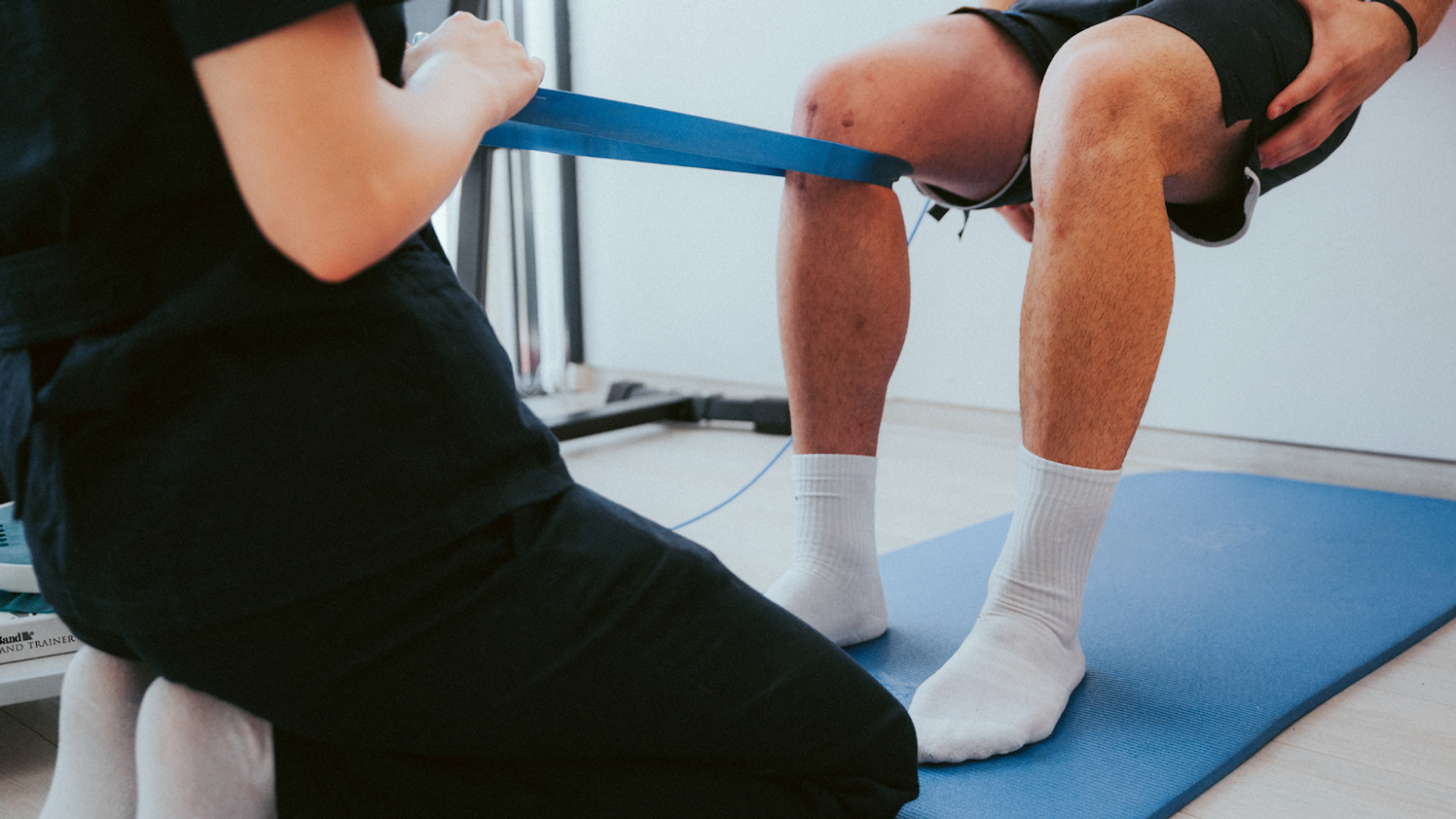
How Personal Training Can Help You Recover From an Injury
Nobody is 100% protected from injury, especially if you’re an athlete or train regularly. Although maintaining proper form and incorporating appropriate recovery techniques into your exercise routine can make injury less likely, it’s often an inevitable part of life.
But what happens next?
First of all, we don’t want to sugarcoat things. While injuries are normal, they can interrupt your workouts and affect your motility, confidence, and overall well-being. Recovery can feel like a long and uncertain process, whether it’s a sprained ankle, back strain, or lingering joint pain.
Many people are unsure how to safely return to movement without making things worse. That’s where personal training for injury recovery can make all the difference. With the right guidance, recovery becomes more structured, more empowering, and more effective.
In this blog, we’ll explore how personal trainers help clients heal, rebuild strength, and suggest safe exercise techniques that can be done from home. But first, it’s important to understand the science behind injury recovery and why gentle exercise can often help the healing process instead of hindering it.
Let’s begin!
Why Do Injuries Require More Than Just Rest To Heal?

While rest is vital in the early stages of recovery, it’s only part of the equation. In order to regain strength, mobility, and function, the body needs progressive movement. Of course, this doesn’t mean jumping into high-intensity workout sessions the second you feel better, but rather incorporating movement gradually into the recovery phase.
Unfortunately, many people don’t know when or how to start exercising again safely. That lack of direction often leads to prolonged discomfort, stiffness, and a reduced ability to return to previous activity levels.
Personal training can work wonders for injury recovery. Personal trainers are equipped to deal with various injuries and know what movements to incorporate into a recovery routine to prevent further pain or discomfort.
That said, let’s take a closer look at the benefits of hiring a personal trainer during the recovery phase:
Preventing Long-Term Complications and Weakness
When movement stops completely after an injury, the body quickly begins to adapt in unhelpful ways. Muscles can atrophy, joints lose their range of motion, and postural imbalances may develop. If not addressed properly, these issues can lead to chronic pain or future injuries.
Personal training reintroduces safe, structured activity that restores mobility and function while helping prevent these long-term setbacks. With careful guidance, you can strengthen the muscles around the injury and regain the support your body needs.
Rebuilding Strength and Stability

After an injury, it’s normal to feel weaker and less stable, especially in the affected area. However, this shouldn’t become the new normal, especially in the long term. The longer you remain inactive, the harder it’s going to be to return to an active lifestyle.
A certified trainer can help rebuild your physical foundation by designing exercises that improve joint stability, restore muscle balance, and gradually reintroduce resistance. They know how to isolate weak points and bring the entire body back into alignment.
Over time, physical activity helps with injury recovery and reduces the chance of future strain or overcompensation in other areas.
Restoring Confidence, Mental Well-Being, and Healthy Habits
Physical injuries often come with an emotional toll. Fear of re-injury, frustration from limited mobility, or a loss of identity as an active person can weigh heavily on your mindset.
Likewise, feeling stuck can also lead to slipping back into bad habits, especially when it comes to nutrition and routine, further chipping away at your confidence.
Personal training provides accountability and encouragement, creating a safe space for gradual progress. With the right support, clients often experience increased confidence, mental clarity, and renewed motivation as they move through each stage of recovery.
Moreover, personal trainers can also make helpful dietary and lifestyle suggestions that further speed up the recovery process, ensuring you get the necessary nutrients and rest your body needs to recover.
What Makes Personal Training Effective For Injury Recovery?

Recovering from an injury isn’t a one-size-fits-all journey. Everyone heals differently, depending on the type of injury, their age, fitness level, and previous training background. What works for one person can often harm another, and vice versa.
This is where personal training really shines. Trainers create recovery programs specifically designed for you, offering a level of customization and attention that generic rehab plans simply can’t match. Also, having a personal trainer by your side adds another layer of safety to your routine, allowing you to heal without fear of re-injury.
Here are just a few of the main ways personal trainers can assist during injury recovery:
Customized Recovery Plans
One of the most significant advantages of personal training is the ability to tailor every aspect of your workout to your current condition. A trainer will evaluate your movement patterns, assess any mobility restrictions, and design a plan that meets your body where it is. Whether you’re working through knee rehabilitation or recovering from a shoulder surgery, your program will reflect your unique needs and healing timeline.
Safe Exercise Progression
Injury recovery is rarely linear, and pushing too hard too soon can result in major setbacks. Personal trainers are skilled at recognizing when you’re ready to progress and when you need to pull back. They monitor your form, adjust exercise intensity, and change the focus of your sessions as required.
This attention to detail ensures you continue to build strength without compromising your recovery or risking a repeat injury.
Working In Collaboration With Healthcare Professionals
Trainers often communicate with physical therapists, orthopedic specialists, or primary care physicians to ensure your fitness plan aligns with medical recommendations. This collaborative approach creates a seamless transition from clinical rehab to independent training. Trainers can help reinforce physical therapy goals while expanding your abilities in a more holistic and sustainable way.
The Benefits Of Working With A Personal Trainer At Home During Recovery
When you're recovering from an injury, convenience and comfort are just as important as exercise selection. While a gym setting may work for some individuals recovering from mild injuries, others may require more support in a comfortable environment.
In-home personal training allows you to heal in a familiar and supportive setting, which can be especially valuable if you're dealing with anxiety, limited mobility, or low energy levels.
Moreover, it removes the stress-inducing social aspect of explaining your injury to acquaintances and workout buddies at the gym, allowing you to focus on healing instead of retelling a painful story.
Recovering In A Familiar, Low-Stress Environment
After an injury, getting to the gym can feel overwhelming. There might be concerns about transportation, using unfamiliar equipment, or working out around others. At-home training removes these barriers by allowing you to focus entirely on your recovery in a comfortable space.
This option can be especially beneficial for people recovering from surgery or dealing with ongoing pain. Training at home helps eliminate external stressors and makes each session more focused and productive.
One-On-One Support Tailored To Your Surroundings
An in-home personal trainer doesn’t just show up with a plan. Instead, they adapt your workouts to the equipment and space you already have. Even if you don’t own gym gear, trainers can create effective routines using bodyweight, resistance bands, and furniture.
This kind of customization makes training accessible to nearly everyone, regardless of their home setup. Plus, the added privacy makes it easier to try new movements without feeling self-conscious.
Maintaining Consistency And Motivation
Staying consistent during injury recovery is key, but it can be tough when progress feels slow. A trainer helps you build momentum, set achievable goals, and teaches you how to stay motivated to workout. They adjust workouts based on your daily energy levels, monitor your progress, and help you celebrate the small wins that lead to significant improvements.
With regular check-ins and expert feedback, clients often find themselves recovering faster and with greater confidence.
How Svetness Supports Personal Training For Injury Recovery

At Svetness, we believe injury recovery should be personalized, empowering, and accessible. Likewise, we acknowledge that not everyone has the opportunity or desire to work out in a gym setting, especially during the recovery phase.
That’s why our in-home training services are designed to support clients through every stage of healing with customized care and expert attention. We work with a wide range of clients, from new moms to professional athletes to senior citizens, developing customized training plans for each individual. When it comes to injury recovery, this level of personalization is vital!
Experienced, Certified Trainers Who Understand Injury Recovery
Svetness trainers are highly experienced and certified through reputable organizations. Many have additional education in corrective exercise and functional movement, making them well-equipped to guide clients recovering from a wide range of injuries. They understand how to safely strengthen compromised areas while avoiding movements that could delay healing. You can expect every session to reflect best practices in injury recovery and rehabilitation.
A Fully Customized Approach With Ongoing Progress Tracking
Our training programs aren’t just one-time plans. They evolve with you. Your trainer will conduct assessments, track milestones, and refine your routine based on how your body responds over time. This ongoing adjustment ensures that you’re not just moving, but progressing in the safest and most effective way possible. You’ll be able to measure improvement in strength, mobility, and confidence as your sessions continue.
Flexible Scheduling And Virtual Options
Life doesn’t pause during recovery, which is why we offer flexible scheduling to accommodate your routine. Whether you prefer early mornings, evenings, or weekends, our trainers work around your availability. For those who travel or need remote support, virtual sessions offer the same expert guidance and accountability without the commute. We make it easy to prioritize your health, no matter what your schedule looks like.
Final Thoughts
Injury recovery takes time, patience, and the right support system. Resting is essential, but movement is what brings your body back to strength. While remaining sedentary during the initial recovery phase can be beneficial, the right amount of gentle movement later on helps many people recover quickly and effectively.
However, your recovery journey shouldn’t be a one-person effort or a guessing game. Working with a professional ensures that each step of your recovery is guided, intentional, and aligned with your goals. Moreover, personal trainers are equipped to deal with various injuries, ensuring your recovery program is genuinely helpful and doesn’t cause further damage.
With personal training for injury recovery, you’re provided with customized workouts, expert oversight, and one-on-one support in a setting that works for you. And with Svetness, you don’t have to go through it alone. Our in-home personal trainers are ready to help you rebuild your strength and confidence with care, safety, and encouragement. The best part? You don’t even have to leave the comfort of your own home!
If you’re ready to take the next step in your healing journey, explore our personal training services for injury recovery.
Frequently Asked Questions
Can I start personal training immediately after an injury?
It depends on the severity and type of your injury. In most cases, it’s best to wait until you have clearance from your doctor or physical therapist. Once you have the green light, a trainer can help ease you back into movement safely and effectively.
How do trainers know which exercises are safe for my injury?
Trainers assess your current condition, consider any medical advice, and rely on their training to choose safe and effective exercises. They also monitor your form and adjust the plan as needed to keep your recovery on track.
What if I have chronic pain or recurring injuries?
Chronic issues require a long-term strategy. Personal trainers are skilled in managing ongoing pain by building strength, improving mobility, and correcting movement patterns. Over time, this approach can reduce flare-ups and improve quality of life.
Is personal training for injury recovery suitable for older adults?
Yes. Recovery-focused training can greatly benefit older adults, especially those dealing with joint replacements, surgeries, or balance concerns. Our trainers offer senior-friendly fitness routines to meet individual needs and ensure safe progression at any age.
Start your Svetness journey today
Get a free consultation and see how our trainers can transform your wellness journey.





